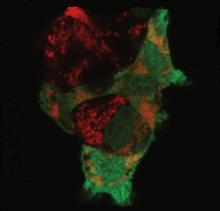Study Reveals New Targets for Parkinson’s Disease
Study Reveals New Targets for Parkinson’s Disease
Scientists used a novel approach to identify dozens of genes that may contribute to Parkinson’s disease. The discoveries may also yield insights into other disorders that involve mitochondria, the organelles that serve as power plants for our cells.
Mitochondria convert compounds derived from food into the molecules that cells use for energy. Defects in mitochondrial function can lead to disease and have been associated with certain neurological disorders, including Parkinson’s disease, Charcot-Marie-Tooth syndrome, and the ataxias.

Turning off some genes, like HSPAI1L, inhibits parkin (green) from tagging damaged mitochondria (red). Image by the Youle lab, courtesy of Nature.
Some cases of Parkinson’s disease have been linked to mutations in the gene that codes for parkin, a protein that cells use to tag damaged mitochondria as waste. Once tagged, damaged mitochondria are degraded by lysosomes, the cell’s trash disposal system. Known mutations in parkin prevent this tagging and result in the accumulation of unhealthy mitochondria.
A team led by Dr. Richard Youle at NIH’s National Institute of Neurological Disorders and Stroke (NINDS) used RNA interference (RNAi) to screen for genes that help parkin tag damaged mitochondria. RNAi is a natural process that cells use to turn down, or silence, the activity of specific genes. Since its discovery in 1998, scientists have used RNAi as a tool to investigate the function of genes and their involvement in health and disease.
Working in collaboration with RNAi expert Dr. Scott Martin’s team at NIH’s National Center for Advancing Translational Sciences (NCATS), the researchers used robotics to introduce small interfering RNAs (siRNAs) into human cells to individually turn off nearly 22,000 genes. Using automated microscopy, they then examined how silencing each gene affected the ability of parkin to tag mitochondria. The results appeared online on November 24, 2013, in Nature.
The researchers found that dozens of candidate genes affected parkin tagging. Turning off some, such as TOMM7 and HSPAI1L, inhibited parkin tagging. Switching off others, including BAG4 and SIAH3, enhanced tagging. Many of these genes have been found in previous studies to encode mitochondrial proteins or to help regulate ubiquitination, a process that cells use to mark proteins for degradation.
The researchers tested one of the genes, TOMM7, in human nerve cells. Turning off TOMM7 inhibited tagging of mitochondria in these cells as well. The results suggest that many of the genes identified in this study may work like quality control agents in a variety of cell types, including neurons.
“We discovered a network of genes that may regulate the disposal of dysfunctional mitochondria, opening the door to new drug targets for Parkinson’s disease and other disorders,” Youle says.
![]()
###
* The above story is reprinted from materials provided by National Institutes of Health (NIH)
** The National Institutes of Health (NIH) , a part of the U.S. Department of Health and Human Services, is the nation’s medical research agency—making important discoveries that improve health and save lives. The National Institutes of Health is made up of 27 different components called Institutes and Centers. Each has its own specific research agenda. All but three of these components receive their funding directly from Congress, and administrate their own budgets.




















